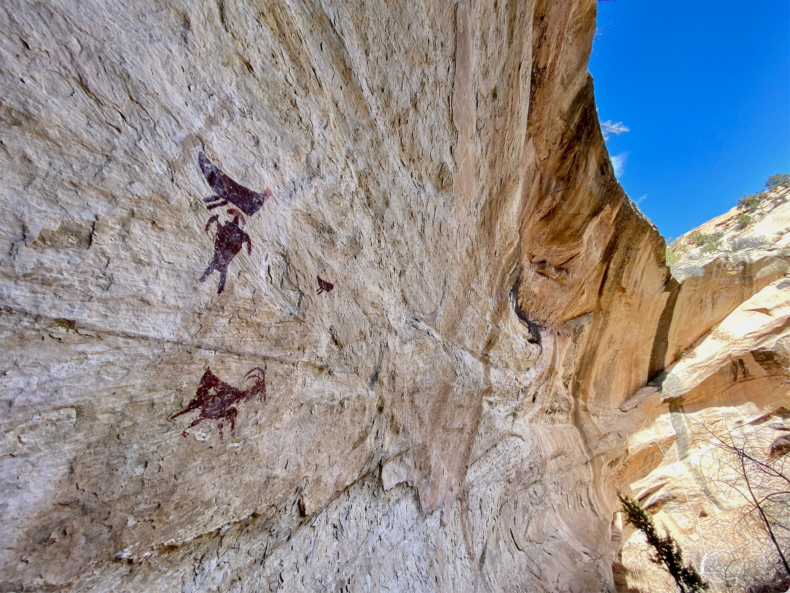
In North America, the oldest images put onto rock date back to almost 13,000 BC, deep in the Ice Age. Those types are rare. Most of what you see — phantom-body figures, snakes, lightning bolts, shields, hunting scenes — come from the last handful of millennia, animistic hunter-gatherers and corn-bearing agrarians, the rise of Native America.
Last month I had a new book come out, “Tracing Time: Seasons of Rock Art on the Colorado Plateau” (Torrey House Press 2022). It was my ‘pandemic book’, the thing I wrote during lockdowns when I spent more time with ghosts and serpent gods than I did with living people. After decades of establishing connections in Indigenous and scientific circles, I decided it was time to write about images that, once you start looking, you find all around you, every inhabitable continent scribed and painted with this kind of ancestry.
I live on the Colorado Plateau, a swollen, high-desert landmass pushing up on the Four Corners. Cliffs and boulders are well decorated with rock imagery, what is sometimes called rock writing. If you spend time here, you can’t help seeing it, taken to a panel on a rancher’s land, or pulling off the side of the highway with binoculars, looking up a cliff at a dizzying array of dancers. Who are these people, what were they saying, and what are they saying now? These were the subjects I wrote about in the book.
Rock art can be rubbing, scratching, pecking, painting. A pictograph is painted. In green, red, yellow, and white, you’ll see strokes of big yucca brushes being used a thousand years ago, or sometime a two-hair brush depicting the feathers of a tiny bird. A petroglyph is chipped into the rock, often with a hammerstone and a bone chisel. Sharpened deer leg bones work best. This reveals brighter material underneath, a painstaking process, shoulder against the wall, blowing out dust, pinky fingernail scratching out lodged sand grains. In their day, when they were fresh, these petroglyphs would have popped like neon, as bright and dynamic as any paint.
Each rock art site requires its own kind of study, different light of day, coming by flashlight or moonglow. Morning and evening can be soft and coppery while midday is washed in sunlight, cliffs as shiny as mirrors. Late afternoon in December is some of the best light, warm and spectral.
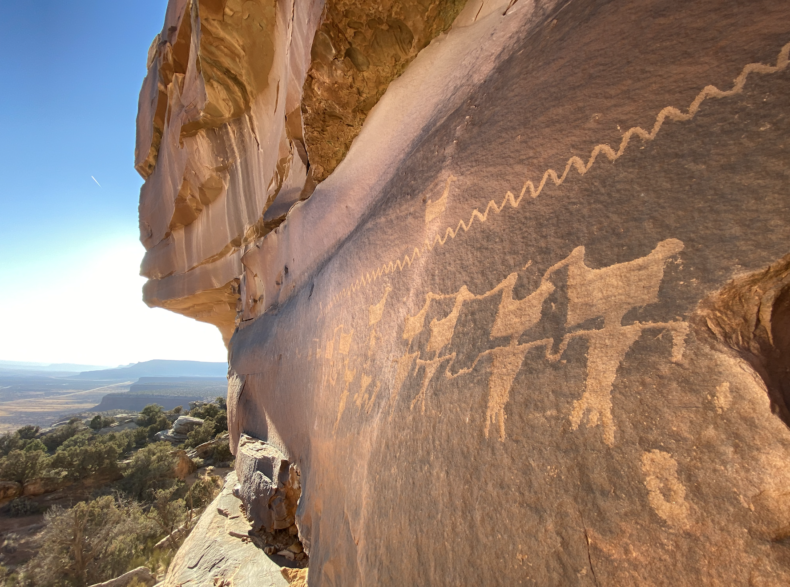
Not far off a dirt road in Utah, easy to reach in the dark without a headlamp, I went to a single pictograph site four autumn mornings in a row. This is where you sit and stare at nothing, a boulder the size of a house lightless, the sky around it bannered with stars. Sit and wait.
First layers of indigo in the east outlined the boulder and several minutes later, red dancers appeared as if rising out of a well. They were in a circle holding hands, painted in red hematite, then scratched with sharpened tools. The pigment, a red ochre, had been mixed with a protein binder, something like blood, semen, or egg white, which fused the paint into the rock grains. I’d put the work around a thousand years old, the Fremont culture. The only way to get a solid date from a site like this is to put a mass spectrometer to the paint, which would be a destructive process. You get a rougher and useful enough date by style and relationship to surrounding archaeological sites.
A pantheon appeared with the coming light. The circle of hand-holders had a flute player on one side. On the other was a god-like figure holding a staff that appeared to be shooting out lightning. Or was it a warrior bracing for battle, or a magician casting a spell? Questions like this can go on forever.
A Zuni weaver and farmer I know, direct descendent of the makers of some of the rock art around the Four Corners, said that enlarged human-like figures, like the one holding a staff and shooting lightning, are ‘spirit beings’. He said the word in English means raw. When you’re born, he said, you’re raw, and when you’re old or dying, you’re raw. That is, closer to the spirit world, the things we don’t see that are happening all around us. When he said the word in Zuni, it sounded like small shells tumbling over each other in the water. I counted nineteen syllables.
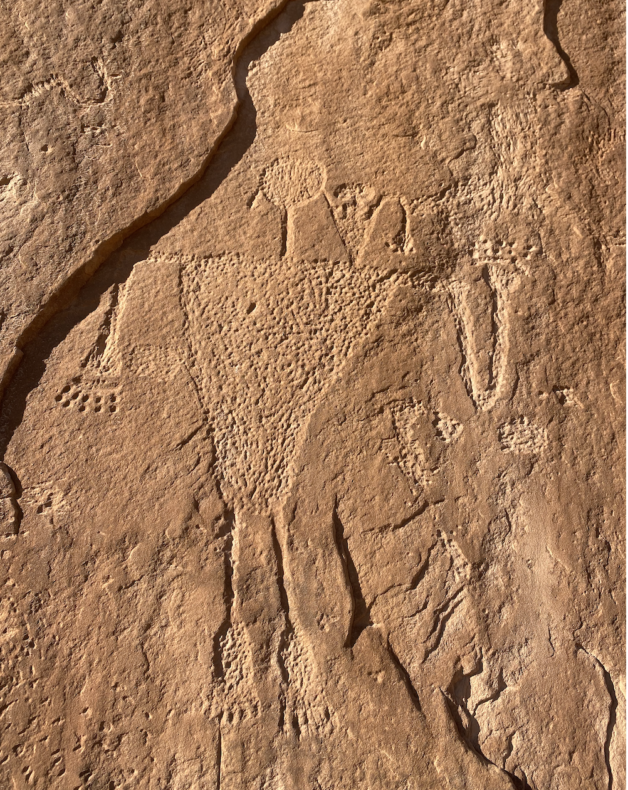
As the eastern horizon turned yellow, fields of red thumbprints on the rock appeared like a rainstorm descending on the circle-dancers. I imagined this as a depiction of an event, a dance in the rain, a flute player calling, a sky god unleashing thunder, and seconds later rain comes down in a gush. You’d see this kind of event at Hopi or any of the New Mexican pueblos. When rain hits during ceremonies, dancers in the plaza, even those wearing regalia and wooden, painted tablitas, don’t run for cover. They dance harder and the drums grow louder, which is what I imagined depicted on this thousand-year-old rock art panel.
As light came on, the boulder became messy with graffiti and names of Anglo settlers and ranchers. People had scratched and chiseled with steel over older figures. The site began to look more like a pissing post than a creation story.
For about twenty minutes each morning, when the horizon was a thin, vibrant line, this overlay of recent history peeled away. I saw the first imagery as it had been intended, the original art. Instead of photographic enhancement or bouncing electromagnetic waves through the rock, I found sunrise an ample technique. This is why I returned each morning at the same time. I’d look into this well of paintings as if it had been applied yesterday, later claims and vandalism removed.
The sun arrived like a deep exhale. The air moved, leaning to the east as if pulled in by the light. Pink and orange dappled the rock, moving across names, dates, and places. Something important happened here, something that matters, enough to lure people back to this spot centuries later. A deed was signed here, a prayer was sent. You may not know what rock art means or why it was put in this place, but know that it mattered. This is where they laid their stories down.
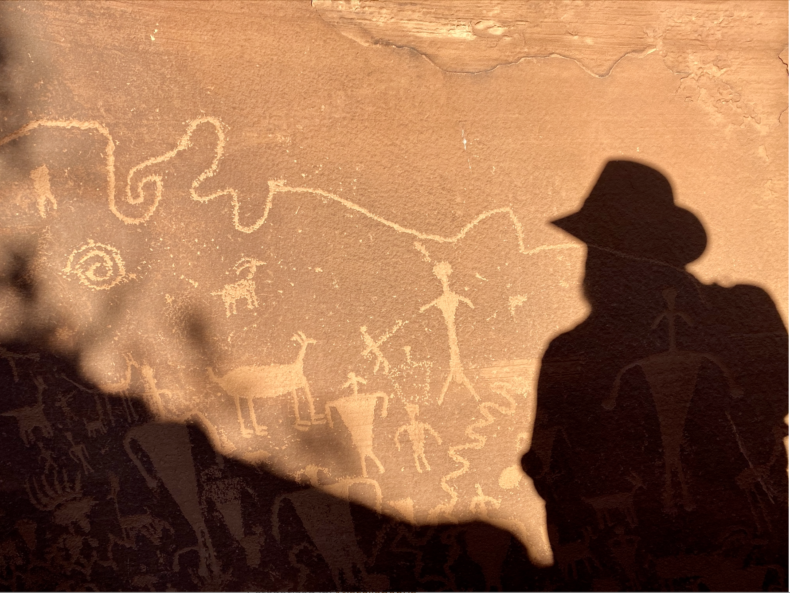
Images: Craig Childs
My new book, btw! Ask for it, at your nearest independent bookseller.
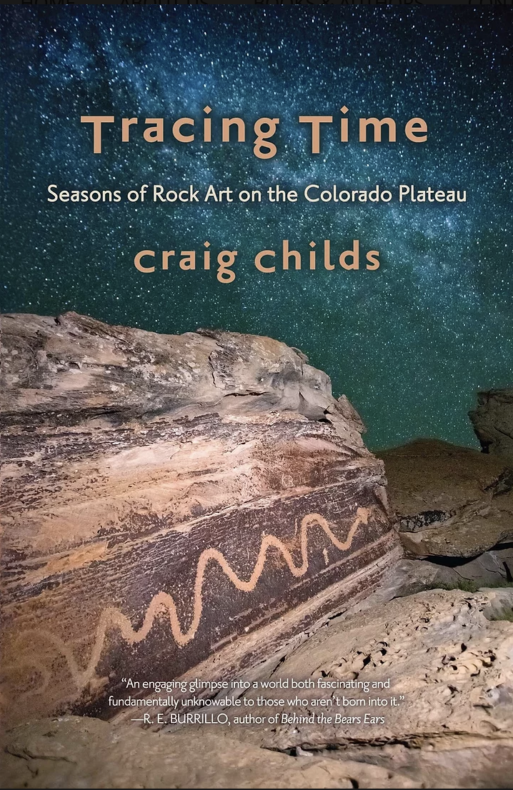
Thank you, Craig! We received our copies (yes, copies) of Tracing Time and can’t wait to read them and learn more.
Beautiful story, Craig. Stunning in the way light affects rock art and one’s “seeing” of it. Though “graffiti” disturbs the reverie felt when admiring the original story laid down in the rock, the other signatories are laying down their stories as well. The wolp in the wilderness, so to speak. “I was here and mattered.” I guess it’s a trait of humans everywhere to leave some tell-tale sign of their passage. A pile of stones. A sticker on a roadside metal barrier. A dollar bill inscribed with a name and date tacked to a barroom ceiling. We do hate to be anonymous, don’t we? I guess that’s why I leave comments on feeds.